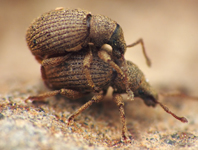Abstract
After reconstructing the phylogenetic relationships among the closely related genera Carbula Stål, Eysarcoris Hahn, and Stagonomus Gorski (tribe Eysarcorini), using the mitochondrial genes: 16S rRNA and cytochrome oxidase subunit I (COI), and incorporating morphological characters to contrast our data, we transfer the species Eysarcoris gibbosus Jakovlev and Eysarcoris venustissimus (Schrank) to the genus Stagonomus, and we propose to place the subgenus Dalleria Mulsant & Rey as a synonym under the nominal subgenus Stagonomus. Additionally, Stagonomus is redefined to include diagnostic characters of the male genitalia.
References
Aukema, B., Rieger, Ch. & Rabitsch, W. (2013) Catalogue of the Heteroptera of the Palaearctic Region. VI. Supplement. The Netherlands Entomological Society, Amsterdam, xxiv + 629 pp.
Belousova, E.N. (2007) Revision of the shield-bug genera Holcostethus Fieber and Peribalus Mulsant et Rey (Heteroptera, Pentatomidae) of the Palaearctic region. Entomologicheskoe Obozrenie, 86 (3), 610–654 [English translation in Entomological Review, 87 (6), 701–739.
https://doi.org/10.1134/S0013873807060085
Costa, A. (1847) Cimicum regni Neapolitani centuria secunda decas sexta, septima, octava, nona et decima. Reale Istituto d’Incoraggiamento alle Scienze Naturali di Napoli, 7, 1–41.
De la Fuente, J.A. (1973) Revisión de 1os Pentatómidos Ibéricos. Parte II: Tribus Aelini Stål, 1872, Stagonomini nov. nom. (= Eysarcorini Auct.) y Carpocorini Distant, 1902. Eos, 48, 115–201.
Derjanschi, V.V. & Péricart, J. (2005) Faune de France, 90. Hémiptères Pentatomoidea euro-méditerranéens 1. Généralités. Systématique: Prémiere Partie. Fédération Française des Sociétés de Sciences Naturelles, Paris, 494 pp.
Folmer, O., Black, M., Hoeh, W., Lutz, R. & Vrijenhoek, R. (1994) DNA primers for amplification of mitochondrial cytochrome c oxidase subunit I from diverse metazoan invertebrates. Molecular Marine Biology and Biotechnology, 3, 294–299.
Isakov, Y.M. (2000) Notes on the taxonomy and bionomics of Stagonomus bipunctatus (Heteroptera, Pentatomidae). Vestnik zoologii, 34 (3), 83–88.
Josifov, M.V. & Kerzhner, I.M. (1978) Heteroptera aus Korea. II. Teil (Aradidae, Berytidae, Lygaeidae, Pyrrhocoridae, Rhopalidae, Alydidae, Coreidae, Urostylidae, Acanthosomatidae, Scutelleridae, Pentatomidae, Cydnidae, Plataspidae). Fragmenta Faunistica, 23 (9), 137–196.
https://doi.org/10.3161/00159301FF1978.23.9.137
Kambhampati, S. & Smith, P.T. (1995) PCR primers for amplification of four insect mitochondrial gene fragments. Insect Molecular Biology, 4, 233–236.
https://doi.org/10.1111/j.1365-2583.1995.tb00028.x
Katoh, K. & Standley, D.M. (2013) MAFFT Multiple Sequence Alignment Software Version 7: Improvements in Performance and Usability. Molecular Biology and Evolution, 30 (4), 772–780.
https://doi.org/10.1093/molbev/mst010
Kaur, R., Singh, D. & Kaur, H. (2013) Taxonomic significance of external genitalia in differentiating four species of genus Carbula Stål (Heteroptera: Pentatomidae) from North India. Journal of Entomology and Zoology Studies, 1 (3), 33–42.
Kiritshenko, A.N. (1951) Keys to the Fauna of the USSR. Vol. 42. True bugs of the European part of the USSR (Hemiptera): Key and bibliography. Academy of Sciences of the USSR, Moscow, Leningrad, 42 + 423 pp.
Lee, J.G., Hong, S.S., Kim, J.Y., Park, K.Y., Lim, J.W. & Lee, J.H. (2009) Occurrence of stink bugs and pecky rice damage by stink bugs in paddy fields in Gyeonggi-do, Korea. Korean Journal of Applied Entomology, 48 (1), 37–44.
https://doi.org/10.5656/KSAE.2009.48.1.037
Li, R., Zhang, H., Li, S. & Bai, M. (2017) Geometric morphometric analysis of Eysarcoris guttiger, E. annamita and E. ventralis (Hemiptera: Pentatomidae). Zoological Systematics, 42 (1), 90–101.
Linnavuori, R. (1982) Pentatomidae and Acanthosomatidae (Heteroptera) of Nigeria and the Ivory Coast, with remarks on species of the adjacent countries in West and Central Africa. Acta Zoologica Fennica, 163, 1–176.
Lupoli, R. & Dusoulier, F. (2015) Les punaises Pentatomoidea de France métropolitaine. Éditions Ancyrosoma, Fontenay-sous-Bois, 429 pp.
Maddison, W.P. & Maddison, D.R. (2011) Mesquite: A Modular System for Evolutionary Analysis. Version 2.75. WWW document. Available from: http://mesquiteproject.org/ (accessed 25 February 2019)
Miller, M.A., Pfeiffer, W. & Schwartz, T. (2011) The CIPRES science gateway: a community resource for phylogenetic analyses. In: Proceedings of the 2011 TeraGrid Conference: Extreme Digital Discovery. ACM, New York, New York, pp. 41.
https://doi.org/10.1145/2016741.2016785
Nasiruddin, M. & Roy, R.C. (2012) Rice field insect pests during the rice growing seasons in two areas of Hathazari, Chittagong. Bangladesh Journal of Zoology, 40 (1), 89–100.
https://doi.org/10.3329/bjz.v40i1.12898
Puton, A. (1886) Catalogue des Hémiptères (Hétéroptères, Cicadines et Psyllides) de la faune Paléarctique. Société Français d’Entomologie, Caen, 100 pp.
Rider, D.A. (2006) Family Pentatomidae. In: Aukema, B. & Rieger, C. (Eds.), Catalogue of the Heteroptera of the Palaearctic Region. Vol. 5. The Netherlands Entomological Society, Amsterdam, pp. 233–402,
Rider, D.A., Schwertner, C.F., Vilímová, J., Rédei, D., Kment, P. & Thomas, D.B. (2018) Higher systematics of the Pentatomoidea. In: McPherson, J.E. (Ed.), Invasive Stink Bugs and Related species (Pentatomoidea): Biology, Higher Systematics, Semiochemistry, and Management. CRC Press, Boca Raton, Florida, pp. 25–201.
https://doi.org/10.1201/9781315371221-2
Ronquist, F. & Huelsenbeck, J.P. (2003) MrBayes 3: bayesian phylogenetic inference under mixed models. Bioinformatics, 19, 1572–1574.
https://doi.org/10.1093/bioinformatics/btg180
Seidenstücker, G. (1965) Stagonomus devius n. sp., eine neue Schildwanze aus der Türkei (Heteroptera, Pentatomidae). Reichenbachia, 5, 9–19.
Stamatakis, A. (2006) RAxML-VI-HPC: maximum likelihood-based phylogenetic analyses with thousands of taxa and mixed models. Bioinformatics, 22, 2688–2690.
https://doi.org/10.1093/bioinformatics/btl446
Stamatakis, A., Hoover, P. & Rougemont, J. (2008) A rapid bootstrap algorithm for the RAxML web-servers. Systematic Biology, 75, 758–771.
https://doi.org/10.1080/10635150802429642
Sun, X. (2011) Study on the taxonomy of five genera of Pentatominae from China (Hemiptera: Heteroptera: Pentatomidae). Nankai University, Nankai, 117 pp. [unpublished dissertation thesis]
Tamura, K., Peterson, D., Peterson, N., Stecher, G., Nei, M. & Kumar, S. (2011) MEGA5: Molecular Evolutionary Genetics Analysis (MEGA) software version 5.05 using Maximum likelihood, Evolutionary Distance and Maximum Parsimony Methods. Molecular Biology and Evolution, 28, 2731–2739.
Wagner, E. (1964) Die Gattung Stagonomus. Deutsche Entomologische Zeitschrift, 1964, 1–10.
Wolff, J.F. (1804) Icones Cimicum descriptionibus illustratae. Fasc. 4. Apud Ioann. Iacobum Palm, Erlangae, 40 pp. [pp. 127–166]
https://doi.org/10.5962/bhl.title.15807
Wood, I. & McDonald, F.J.D. (1984) Revision of the Australian Eysarcoris group (Hemiptera: Pentatomidae). Australian Journal of Entomology, 23 (4), 253–264.

